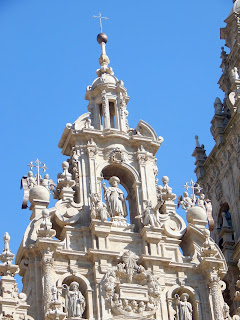We enjoyed a luxury five hour bus ride along the northern coast from Gijon, turning south and inland a bit at Coruna, arriving in Santiago at 2:30PM. Within minutes we'd hailed a cab and were at the door of Hedrass Pension, our home for the next few days.
Our welcome was fun and funny. I buzzed the intercom and a women's voice spoke rapidly in Spanish (as everybody does here even after it's obvious we don't have the language), so I pushed the door once and nothing happened and then pushed it again and it opened. Esther greeted us and chatted away adding gestures to directions in Spanish, showing us the bathrooms, the sitting room, and our bedroom. One of our observations is that when you say you don't understand folks add gestures as they continue chattering away rapid-fire. Esther was really animated, clearly happy to welcome and help us—she was adorable.
 |
| The bus was practically empty leaving Gijon. |
 |
This ALSA bus was called Supra Economy; the seats were
wider, more comfortable and the seat backs offered a wider
array of entertainment. |
What we really enjoyed was the scenery. Here's a sample taken from the bus.
 |
View of Hedrass Pension. From
the street, you'd never notice it. |
 |
Just inside the door, you're greeted
by St. James' Cross and a scallop
shell—two symbols of the El
Camino de Santiago. |
 |
The bathroom is next door to our
room and it's HUGE! |
 |
Our room isn't fancy but it's clean
and comfortable and in the heart
of the Old Town. |
And here are a few pictures we took on our orientation walk our first afternoon in Santiago de Compostela.

 |
Although 80F (27C), the covered archways
and narrow medieval streets keep it cool. |
 |
Ya have to get used to turning around and
seeing yet another 17th century church. This
one is now part of the University of Santiago
de Compostela, established in 16th century. |
 |
| Then there's the more whimsical shop displays. |
 |
| Wouldn't you love owning this house? |
 |
A letter carrier scooter parked in front
of Church of San Bieito do Campo
(985-1003) was renovated 12th century
in Romanesque style, in the 14th
century the door was remodeled,
and then in the 18th century all that
work was demolished and this Neo-
classical facade was added. The bell
tower is still medieval.
We watched the letter carrier scurry
around the church looking a number
to deliver a package. He didn't care
about anything else.
|
 |
| Used books for sale on Cervantes Plaza. Ya, that's appropriate. |
 |
St. Martin Monastery (16th century). About 40 nuns still live
cloistered lives in this Benedictine Monastery. |
 |
| Santiago Cathedral from the exit. |
 |
Hospital of the Catholic Monarchs, established by Ferdinand
and Isabella in the 15th century (i.e. 1492—you know the
ditty). It's now a hotel. |
 |
Gargoyles, window and balcony designs of hospital date
back to 1511.
|
 |
| Former Hospital of the Catholic Monarchs main entrance. |
 |
| Sardine boats exhibited in the main square fronting Cathedral. |
 |
| Santiago Cathedral (1075) from Raxoi Palace on main plaza. |
 |
| Baroque facade of the Cathedral completed 1740. |
 |
Raxoi Palace (1766) faces the Cathedral on the Praza
do Obradoiro, the main plaza.
|
 |
Covered walkway along Raxoi Palace. The arched walkways
throughout the Old Town are gorgeous and reminiscent of,
La Rochelle, probably because they were built in same era. |
 |
| Right, another chapel behind Raxoi Palace. |
 |
| Pilgrims taking a break in the shade of Raxoi Palace. |
 |
| Typical medieval street. |
 |
| Of course, the scallop shell symbol is everywhere. |

 |
Like La Rochelle narrow alleyways connect
main streets, making for handy short cuts. |
 |
Just can't get enough of the arched walkways.
|
 |
And here's what they look like from across the street where I'm
standing under, you guessed it, an arched walkway. |
 |
We enjoyed a stroll through Alameda Park this morning. Oh
ya, and there's the Cathedral again.
|
 |
| Alameda Park is large and a quiet oasis in this bustling city. |
 |
| Artwork decorates buildings wherever you glance. |




















































No comments:
Post a Comment